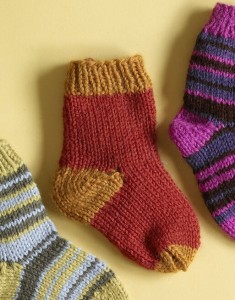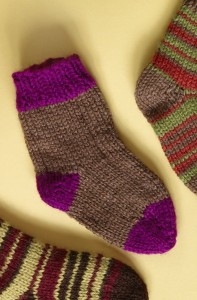Why are socks so popular to make right now? Socks are a great easy-to-carry project and they’re compact and satisfying to make. Over the next few months, we will be showing you different ways to embellish your sock patterns. In our first installment, we featured a basic, solid kids’ sock. In this article, we feature a two-color sock.
Color adds so much to your wardrobe. It also says so much about your personality. Adding color to the heel, toe, and cuff of this sock pattern is a simple way to make your basic sock more exciting. This simple concept of adding color to a few details of a project can be applied to any item. Make your color and cuffs a different color the next time you make a jacket or make the strap of your next bag or purse a contrasting color. Let your imagination run wild.
But how do you pick colors that will work well together? Here are some tips:
- When in doubt, make a swatch. Don’t start a big project with two yarns unless you are sure that you are happy with them. This will save you a lot of ripping out later on.
- Choose colors in the same family. You may know that reds, yellows, and oranges are warm colors and that greens, blues, and purples are cool colors. Colors in the same family will generally look good together. Olive green and purple? Gorgeous. Terra cotta red and gold (like sock #1 above)? Lovely! Colors in the same family are generally a safe bet.
- Don’t be afraid of contrast. Sock #2 above pairs Wool-Ease in a soft Seaspray with a deep Burgundy. Blue and burgundy red are definitely not in the same family, but why do they work? The burgundy red is deep and has some purplish tones, which makes it appropriate to pair with the light blue. It also provides a welcome contrast. The depth of the burgundy makes the paleness of the blue a more interesting color choice. Don’t be afraid to experiment.
- Pair colors with neutrals. Neutrals are browns, grays, black, creams and white. Pairing a bright color with a neutral color (like in sock #3) is a great way to call attention to a project without using a ton of color. The Cocoa brown body of sock #3 is subtle, but the Zinnia purple is vivid and fun.
- Leave yourself enough yarn to weave in ends.When working with more than one skein of yarn, make sure you leave enough yarn when you change colors so that you can weave in the ends securely.
No matter what the project is, big or small, a little color can go a long way. Remember, don’t be afraid to experiment and choose colors you (or your loved ones) will love.
—
A version of this article first ran in The Weekly Stitch newsletter. Click here to sign up for the newsletter and get articles, free patterns, and exclusive offers in your inbox each week.



4 Tips on Knitting Striped Socks (and Other Projects) | Lion Brand Notebook
[…] to add color and pattern to a basic child’s sock. Click here for part 1 and click here for part 2. This month’s article is all about […]
GrannyD
I hate to be a nay-sayer but the picture shows socks with very little turn in the heel resulting in the sock heel sliding down off the kid heel. I’ve been knitting socks for years and most kids and adults too would rather have a “store-bought” sock than a baggy one that doesn’t hug their heel. I’m just saying.